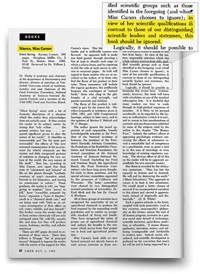Advertisement
Grab your lab coat. Let's get started
Welcome!
Welcome!
Create an account below to get 6 C&EN articles per month, receive newsletters and more - all free.
It seems this is your first time logging in online. Please enter the following information to continue.
As an ACS member you automatically get access to this site. All we need is few more details to create your reading experience.
Not you? Sign in with a different account.
Not you? Sign in with a different account.
ERROR 1
ERROR 1
ERROR 2
ERROR 2
ERROR 2
ERROR 2
ERROR 2
Password and Confirm password must match.
If you have an ACS member number, please enter it here so we can link this account to your membership. (optional)
ERROR 2
ACS values your privacy. By submitting your information, you are gaining access to C&EN and subscribing to our weekly newsletter. We use the information you provide to make your reading experience better, and we will never sell your data to third party members.
Synthesis
Birth Of The Pill: A Romantic Fable
October 27, 2014
| A version of this story appeared in
Volume 92, Issue 43
I find it remarkable that a chemical science magazine would publish a glib review of a glib journalistic rehashed account by Jonathan Eig of the origin of the Pill, which ignores that the work, as with any other synthetic drug, needs to start with chemistry (C&EN, Sept. 22, page 32).
But the really amusing and yet irritating focus on two “mothers of the Pill”—started years ago by Bernard Asbell’s “A Biography of the Drug That Changed the World” and re-Googled by every journalistic author retelling the same Pill story—is risible. First, where is Ludwig Haberlandt? He’s the man who in the 1920s carried out the first experiment on using progestins as a contraceptive and in a book in 1931 predicted the entire oral contraceptive story from a biological standpoint without being cited once by journalistic pseudo-historians of science, who hardly ever research earlier primary literature sources. But here, I simply want to comment on Eig’s assertion that Margaret Sanger and Katharine McCormick were one-half of the quartet that according to Eig was responsible for the Pill.
Some 30 years ago, journalists critical of the fact that the scientific work on the Pill in the 1950s was performed only by male scientists increasingly romanticized these two women as key figures in the development of oral contraceptives. While I find this romanticization charming and emotionally understandable, I nevertheless must emphasize that they had nothing to do with the actual science.
Zero in the case of chemistry, and really only indirectly to the biological work of Gregory Pincus—one of the fathers of the Pill—to whose laboratory McCormick contributed financially. Sanger as a proponent of birth control was, of course, world famous. But anointing her as one-quarter of the Pill Quartet because she reportedly told Pincus that she would like to see a contraceptive Pill in this world is analogous to calling President Richard Nixon one of the scientific fathers in the cancer field because during his term of office he declared a war on cancer with a hoped-for cure in 10 years. Sanger made zero contribution to the science of contraception, which should not demean in any way her role and fame in political or social aspects of birth control as well as an important historical figure in contraception.
What about McCormick? She clearly contributed financially to the early efforts in Pincus’s laboratory, but however commendable such philanthropy is, anointing her as one of “the indisputable mothers of the Pill” (as was started by Asbell and then repeated by many other journalists and historians until being set in cyber-perpetuity through Google and Wikipedia) is as far-fetched as calling John D. Rockefeller one of “the fathers of the Pill.” (The Rockefeller Foundation and its offspring, the Population Council, supported and still support much more research in reproduction and contraception than McCormick ever did and did so over the course of many decades, actually starting with Haberlandt in the 1920s!) Quite bluntly, financial support, valuable as it frequently is, can never be equated with creativity; otherwise, the Medicis would be considered the greatest artists of the Renaissance.
A curious fact not commented upon by any other writers is that Pincus—though dedicating his magnum opus, “The Control of Fertility,” to “Mrs. Stanley McCormick” for “her steadfast faith in scientific inquiry” (but ignoring totally the pioneering biological work of Haberlandt some 20 years earlier)—did not mention any financial support on her part in his acknowledgment section despite a lengthy list of funding agencies, individuals, and companies, notably G. D. Searle & Co.
Carl Djerassi
Stanford University
Stanford, Calif.



Join the conversation
Contact the reporter
Submit a Letter to the Editor for publication
Engage with us on Twitter